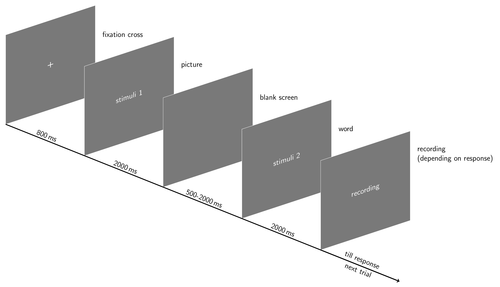A diagram depicting time course of events in an experiment. Every frame represents a screen presented to a participant. This kind of diagram is mostly used in (cognitive) psychology and neuroscience.

Edit and compile if you like:
% Time course of events in an experiment
% Author: Rudolf Siegel
\documentclass[tikz,border=10pt]{standalone}
\usetikzlibrary{positioning}
\begin{document}
\begin{tikzpicture}
\tikzset{
basefont/.style = {font = \Large\sffamily},
timing/.style = {basefont, sloped,above,},
label/.style = {basefont, align = left},
screen/.style = {basefont, white, align = center,
minimum size = 6cm, fill = black!60, draw = white}};
% macro for defining screens
\newcommand*{\screen}[4]{%
\begin{scope}[xshift =#3, yshift = #4,
every node/.append style = {yslant = 0.33},
yslant = 0.33,
local bounding box = #1]
\node[screen] at (3cm,3cm) {#2};
\end{scope}
}
% define several screens
\screen{frame1}{\textbf+} {0} {0}
\screen{frame2}{stimuli 1}{150} {-60}
\screen{frame3}{} {300}{-120}
\screen{frame4}{stimuli 2}{450}{-180}
\screen{frame5}{recording}{600}{-240}
\coordinate [xshift=750,yshift=-300] (frame6);
% add annotations
\foreach \i / \content in {
1/fixation cross,
2/picture,
3/blank screen,
4/word,
5/recording\\(depending on response)
}
\node[label, above right=5em and 1em of frame\i.east]
(f\i-label) {\content};
% add time course
\foreach \j [count=\i] / \content in {
2/800\,ms,
3/2000\,ms,
4/500-2000\,ms,
5/2000\,ms,
6/till response
}
\path[ultra thick] (frame\i.south west) edge
node[timing] {\content} (frame\j.south west);
% some manual addition
\path[ultra thick,->] (frame5.south west) edge
node[timing, below] {next trial} (frame6);
\end{tikzpicture}
\end{document}
Click to download: events.tex • events.pdf
Open in Overleaf: events.tex


